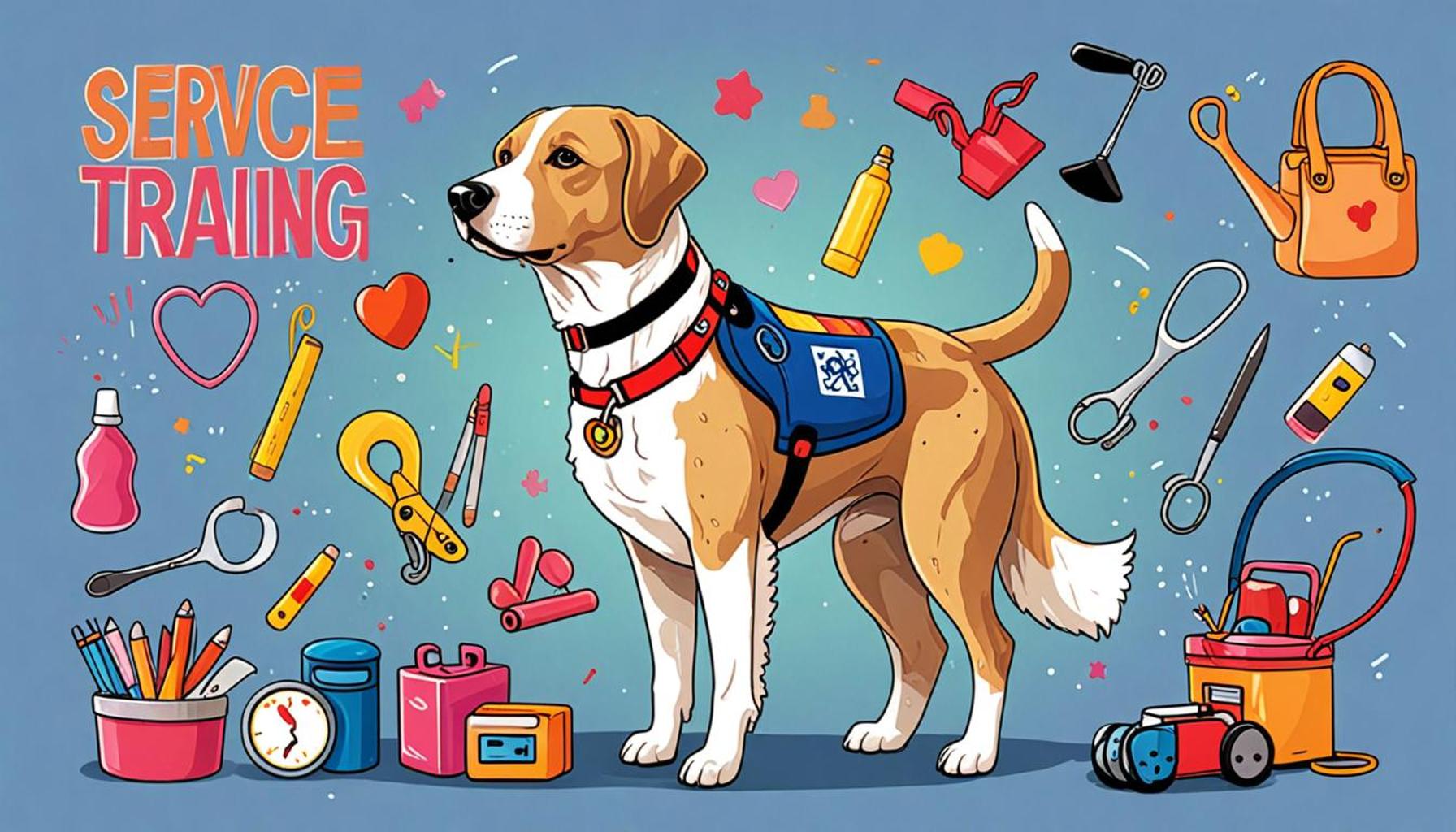Service Dog Training: Preparing Animals to Help People with Special Needs

The Essential Role of Service Dog Training
Service dogs play a critical role in the lives of individuals with special needs, acting as indispensable support mechanisms that extend beyond companionship. These dogs are meticulously trained to assist with a range of challenges, providing practical assistance and enhancing the quality of life for their handlers. The breadth of their training encompasses various skills tailored to meet the unique needs of their users, proving that these canine companions are more than pets; they are vital partners in navigating everyday life.
One of the fundamental components of service dog training is understanding the type of assistance provided. Service dogs are trained to aid individuals facing mobility issues, such as those affected by paralysis, arthritis, or other physical limitations. They can perform tasks like retrieving dropped items, opening doors, or even guiding individuals through crowded spaces. Moreover, dogs trained for medical alerts can sense changes in their handler’s condition, such as a decrease in blood sugar levels for diabetics, and alert them or call for help. Sensory support is another crucial area, particularly for individuals with autism or PTSD, where service dogs are trained to ground their handlers during episodes of anxiety. Lastly, emotional stability is essential; some service dogs are trained to provide comfort during distressing moments, acting as a calming influence that fosters emotional resilience.
The methods employed in service dog training are as varied as the tasks the dogs learn. Professional trainers often utilize positive reinforcement techniques, which involve rewarding desired behaviors to encourage their repetition. This approach not only allows for effective learning but also creates a bond of trust between the dog and handler. Training can take months to several years, depending on the specific skills being taught, the dog’s breed, and individual temperament. Examples of rewards include treats, praise, or playtime, which are integral to motivating dogs and solidifying their learning experiences.
Another key aspect of service dog training is legal recognition and the rights afforded to these animals under the Americans with Disabilities Act (ADA). This legislation classifies service dogs as essential companions, granting them access to public spaces, including restaurants, schools, and workplaces. Understanding these legalities is vital for both service dog handlers and the public, as misconceptions about the rights of service animals still persist.
The journey of training a service dog is more than a series of commands; it is a process that fosters mutual understanding and builds a deep-seated relationship between the dog and its handler. As society continues to increase its awareness of disabilities and the role of assistance dogs, the importance of proper training cannot be underestimated. A well-trained service dog not only enhances an individual’s independence and capabilities but also contributes to the broader discourse on accessibility and support in our communities.
Ultimately, the ongoing education surrounding service dogs and their training is beneficial not only for the individuals they assist but also for the wider community. Encouraging discussions about service dogs can lead to greater empathy, understanding, and support for those navigating challenges with the help of these remarkable animals.
DON’T MISS: Click here to find out how to prepare your home for your new pet</p
Understanding the Different Types of Service Dogs
As the demand for service dogs grows, so does the need for specialized training that meets the diverse requirements of those living with special needs. These remarkable animals come in various breeds and provide a wide range of services tailored to their handlers’ specific situations. Understanding the distinctions between these types of service dogs is essential for appreciating the extensive training they undergo and the support they provide.
One common type of service dog is the mobility assistance dog. These canines are specifically trained to help individuals with physical disabilities, such as those who use wheelchairs or have difficulty walking. Their skills often include:
- Opening and closing doors
- Picking up dropped items
- Bracing to assist with balance
- Pulling wheelchairs or carrying personal items
For those with medical conditions, medical alert dogs serve an essential purpose. They are trained to recognize specific signals that indicate an impending medical crisis, such as:
- Seizures
- Low blood sugar in diabetics
- Allergic reactions
These dogs provide peace of mind to handlers and their families, ensuring that assistance is available when needed most. Their keen sense of smell and sensitive natures allow them to detect these subtle changes in their handlers’ health.
Psychiatric service dogs address the needs of individuals with mental health disorders, such as PTSD, anxiety, and depression. Part of their training may include techniques to:
- Provide deep pressure therapy during anxiety attacks
- Guide individuals through crowded environments
- Interrupt self-harming behaviors
This training not only equips dogs to assist their handlers in everyday life but also focuses on establishing a strong bond that promotes emotional security and stability.
Moreover, when delving into the world of service dog training, it is crucial to recognize the significance of early socialization. Puppies typically start their training between the ages of 8 weeks to 6 months. From this early age, they must be exposed to various environments, people, and situations to help them develop the confidence and adaptability required for their future roles. Socialization sets the foundation for both obedience and the ability to interpret their handlers’ cues.
In addition to early training, ongoing education plays an integral role in the dog’s development. Handlers and trainers work collaboratively to reinforce training commands and ensure the dog fully understands its responsibilities. This continuous learning process not only strengthens the skills of the service dog but also enhances the trust and bond between the animal and its handler, fostering a connection that is essential for effective partnership.
As our society continues to evolve in its understanding of disabilities and the support systems needed for those affected, raising awareness about the different types of service dogs and the training they undergo is critical. The journey of training service dogs reflects a broader commitment to inclusion, support, and empowerment for individuals living with special needs.
| Advantage | Description |
|---|---|
| Enhanced Independence | Service dogs significantly improve the quality of life for individuals with disabilities by facilitating daily activities, allowing greater independence. |
| Emotional Support | These trained animals provide constant companionship, which helps reduce feelings of loneliness and anxiety, offering comfort to their handlers in challenging situations. |
In exploring the profound benefits of service dog training, it’s clear these animals undergo rigorous preparation to assist individuals with special needs. The training equips dogs with specific skills tailored to their handler’s unique requirements, showcasing their invaluable role in society. Understanding the interplay of training, support, and the emotional bond formed between a service dog and its owner opens the door to a broader discussions about the impact of service animals on mental health and daily functionality. Interested readers are encouraged to delve deeper into how this specialized training can change lives.
LEARN MORE: Click here for essential tips
The Training Process: Techniques and Guidelines
After understanding the different types of service dogs, it is important to delve into the actual training process that prepares these animals for their vital roles. The journey from a playful puppy to a skilled service dog is both rigorous and intricate, designed to ensure that these dogs can provide the necessary support to individuals with special needs.
The training process typically begins with basic obedience training, a critical step that lays the groundwork for a service dog’s future skills. Commands such as “sit,” “stay,” “come,” and “leave it” are taught and reinforced in various environments to ensure that dogs can respond reliably, no matter the circumstances. This phase also focuses on house training, socialization, and proper leash manners, all of which contribute to creating a well-adjusted dog.
Once foundational obedience is established, specialized training begins. Trainers utilize positive reinforcement techniques, rewarding desired behaviors with treats, praise, or play. This method not only encourages dogs to learn but also strengthens the bond between the dog and its handler. Each service dog may require unique skills tailored to their handler’s needs, thus training sessions can vary significantly in focus. For instance, mobility assistance dogs might practice bracing while standing still or responding to specific commands to retrieve items, whereas psychiatric service dogs might engage in simulated scenarios that trigger anxiety to practice coping techniques.
As part of the routine, real-world training is essential. Service dogs must be comfortable in a range of public settings, from bustling shopping centers to quiet theaters. They are deliberately exposed to various stimuli, including loud noises, crowded spaces, and different surfaces, to promote adaptability. Additionally, training may involve practicing specific tasks pertinent to their handler’s requirements, such as leading a person through a crowded area or alerting them to an impending medical episode.
Investing extensive time in training does ultimately yield remarkable outcomes; for instance, studies have shown that service dogs significantly enhance their handlers’ quality of life. One survey reported that over 80% of handlers attribute their service dogs’ presence to improved emotional well-being, decreased anxiety levels, and enhanced independence.
Moreover, it is important to recognize the critical role of both handlers and trainers throughout this journey. This is not a process that can be conducted in isolation; effective communication between the handler and the trainer is indispensable. Handlers must be actively involved in reinforcing training techniques at home, maintaining the consistency that service dogs require to thrive. Regular follow-up sessions with trainers often help to assess the dog’s progress and modify training techniques as necessary.
In some cases, organizations provide support for handlers by offering life skills workshops and resources intended to cultivate the handler’s knowledge and confidence. This holistic approach not only benefits the dog but also empowers the handler, ensuring they are fully capable of maximizing the potential support their service dog can offer.
As society continues to advocate for the rights and needs of individuals with disabilities, understanding the service dog training process plays a crucial role in raising awareness and fostering inclusivity. By educating the public about how these dogs are trained, we take steps toward a community that recognizes the invaluable contributions service dogs make to their handlers’ lives.
DISCOVER MORE: Click here for essential tips
Conclusion: The Impact of Service Dog Training on Lives
In conclusion, the journey of service dog training is not merely about teaching commands; it’s a profound commitment to enhancing the lives of individuals with special needs. From the foundational stages of basic obedience to specialized real-world skills, each step is meticulously designed to ensure that these remarkable animals can provide essential support and companionship. The intricate methods utilized during training emphasize the importance of both positive reinforcement and ongoing communication between trainers and handlers, which is vital in maximizing the potential of these service dogs.
As research continues to demonstrate, the presence of a service dog often leads to significant improvements in the emotional and physical well-being of their handlers. With over 80% of handlers reporting increased emotional stability and independence, it is clear that service dogs play a transformative role in their lives. The training process not only empowers the dogs but also equips their handlers with vital skills and confidence through supportive resources and shared learning experiences.
As we strive for a more inclusive society, embracing and understanding the training journey of service dogs is crucial. By shedding light on the complexities involved in preparing these dedicated animals, we foster a deeper appreciation for the bonds they share with their handlers. Service dog training is ultimately a testament to the capability of animals to enhance human lives, paving the way for more opportunities and access to support for those facing challenges. Together, let us advocate for awareness, empathy, and inclusivity, recognizing the invaluable contributions that service dogs make and celebrating the incredible impact they have on communities across the United States.


